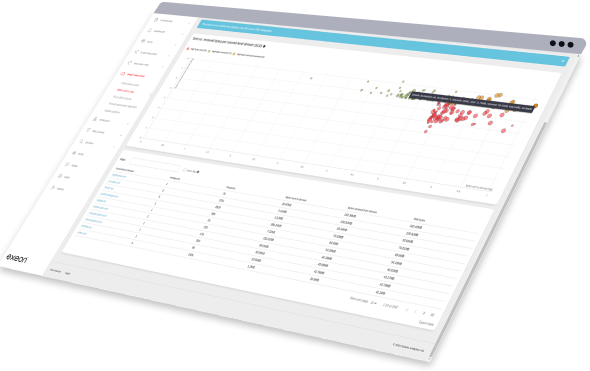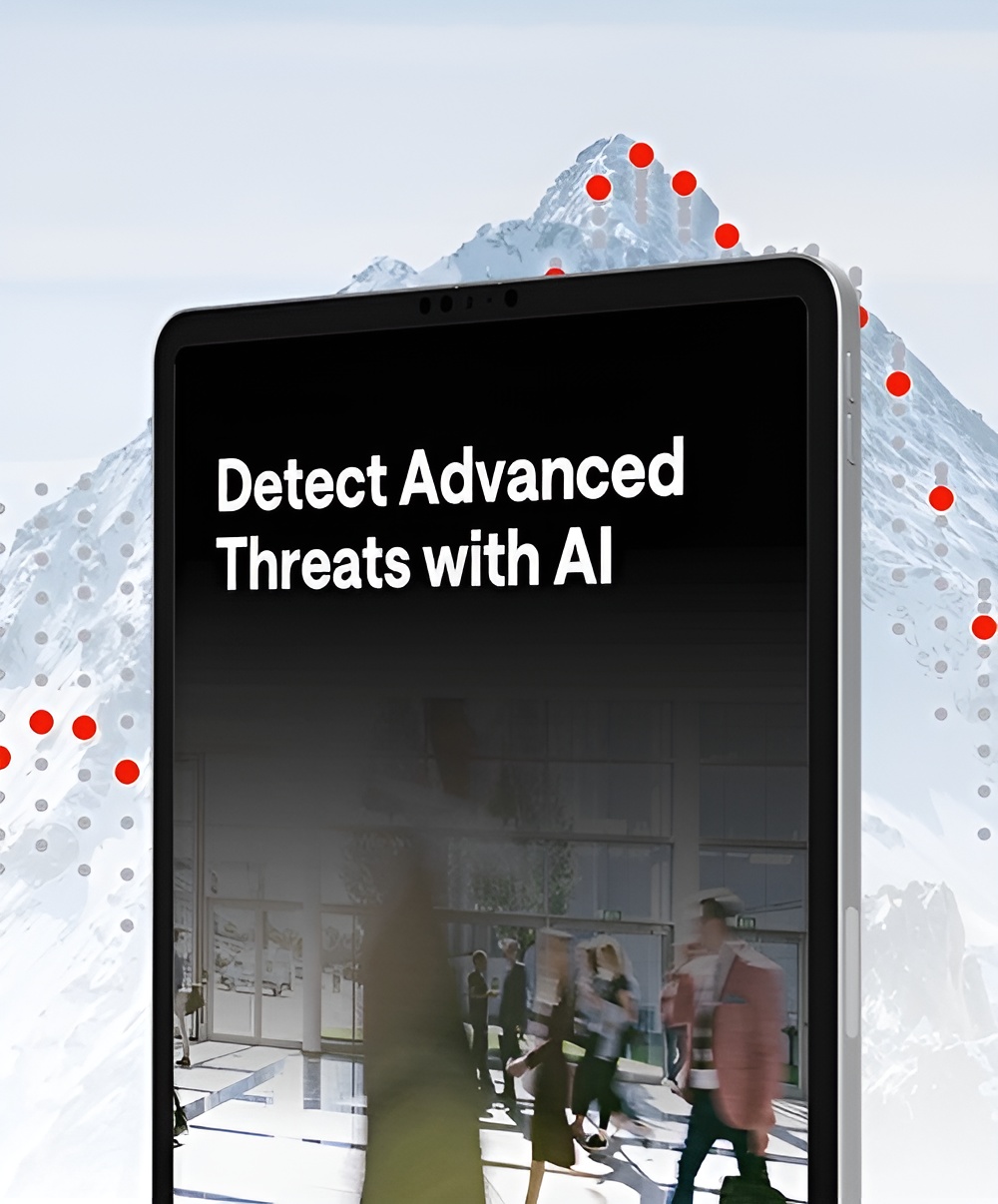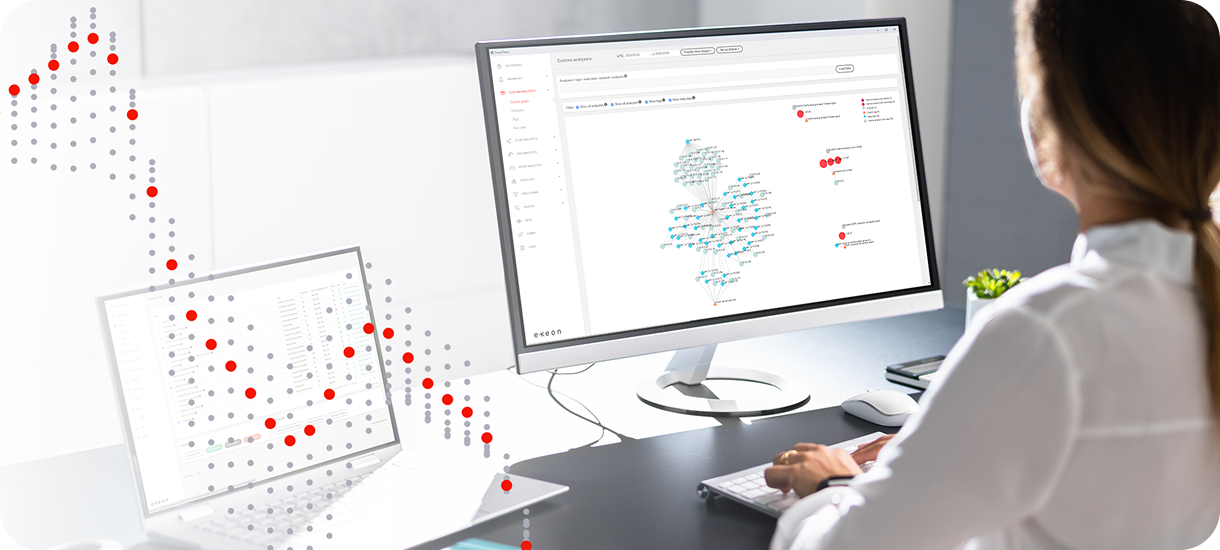Smart Alerting von Exeon: Konzentration auf das Wesentliche
Herausforderungen für Sicherheitsteams
der Unternehmen nennen komplexe und sich weiterentwickelnde Bedrohungen als größte Herausforderung für ihre Cyber-Resilienz.
der Unternehmen sind von Advanced Persistent Threats betroffen, aber nur 30 % verfügen über Echtzeit-Erkennungsfunktionen.
ist der Zeitaufwand, den die Opfer eines Cybersicherheitsangriffs aufwenden, um die erforderlichen Sicherheitsmassnahmen zu ermitteln.
Sicherheitsteams brauchen flexible Whitelisting-Methoden, um vertrauenswürdige Benutzer, Geräte und Prozesse zu definieren, die Genauigkeit der Warnmeldungen zu erhöhen und unnötige Alarme zu minimieren.
Benutzerdefinierte Whitelist-Regeln
Identifizieren Sie das erwartete, bekannte Verhalten von vertrauenswürdigen Benutzern, IPs, Dienstkonten, Geräten oder Prozessen, um sicheren Datenverkehr herauszufiltern, damit Analysten nicht überlastet werden.
Adaptives Lernen
KI-Modelle überwachen das laufende Verhalten und verhindern automatisch, dass bei Mustern, die sich wiederholt als harmlos erweisen, überhaupt eine Warnung ausgelöst wird.
Benutzerzentrierte Kontrollen
Granulare Richtlinien pro Funktion, Netzwerksegment oder Kritikalität ermöglichen es Sicherheitsteams, CMDB-Informationen aus Asset-Datenbanken zu whitelisten und die Erkennungsempfindlichkeit flexibel an die Risikobereitschaft des Unternehmens anzupassen.
Intelligentere Warnungen, schnellere Reaktionen

Dynamische Risikoeinstufung
Analyse der kontextuellen Bedrohung
Automatisierte Korrelation von Vorfällen
Adaptive KI-Modelle
Stärkung von Sicherheitsteams weltweit
















Wie Sie mit Exeon ein fortschrittliches Warnsystem aufbauen
KI-gesteuerte Analytik
Behavioral Machine Learning von Exeon analysiert jeden Datenfluss in Echtzeit und erkennt subtile Abweichungen, die aufkommende Bedrohungen signalisieren – für Frühwarnungen, bevor aus einer Anomalie ein Vorfall wird.
Whitelists intelligent optimieren
Definieren oder importieren Sie vertrauenswürdige Benutzer, Geräte und Prozesse. Exeon unterdrückt deren Routineverkehr automatisch – weniger Rauschen, mehr Fokus auf echte Risiken.
Verhaltensanalysen für tiefere Erkennung
Kontinuierliche Analysen des Benutzer- und Entitätsverhaltens decken Insider-Missbrauch, gestohlene Anmeldedaten und Kontoübernahmen auf – und bringen versteckte, kontextbasierte Bedrohungen ans Licht.
SIEM & SOAR nahtlos integrieren
Exeon liefert risikobewertete Warnmeldungen an Ihren SIEM/SOAR-Stack, löst Playbooks aus, isoliert Hosts in Sekunden und sammelt automatisch Forensikdaten – für schnellere Reaktionen, saubere Analysen und weniger manuelle Arbeit.
Exeon in Aktion

Wie KI bei der Bedrohungsanalyse hilft

Weniger Fehlalarme mit AI

Geführte Bedrohungserkennungstour

KI gegen fortgeschrittene Bedrohungen
Weltweit im Einsatz bei führenden Unternehmen

CISO, SWISS International Airlines
"Als Schweizer Nationalairline treibt uns die Leidenschaft für aussergewöhnliche Leistungen im Sinne unserer Leitsätze an. Eine stabile und sichere IT ist die wichtigste Grundlage für einen exzellenten Kundenservice. Für die Sicherheit der SWISS IT setzen wir Exeon als zentrales Cybersecurity-Tool ein, das vollständig von unserem langjährigen Partner Reist Telecom AG verwaltet wird. Eine perfekte Kombination und Lösung, um unser Netzwerk zu überwachen und Anomalien schnell zu erkennen."

CEO & Gründer, Planzer
"Als CEO und Inhaber einer eng getakteten Logistikfirma kann ich mir Systemausfälle wegen Cybervorfällen nicht leisten. Mit Exeon.NDR haben wir bei Planzer eine Schweizer Lösung gefunden, um unser Netzwerk zu überwachen und Cyberbedrohungen frühzeitig zu erkennen."

Leiter Infrastruktur & Anwendungen, 3 Banken IT
"Wir schätzen vor allem die umfassende Netzwerktransparenz, die uns Exeon.NDR bietet.
Die Anomalieerkennung ist zudem äußerst präzise und ermöglicht es unseren Analysten, sich auf die wesentlichen Bedrohungen zu konzentrieren."

ICT-Projektleiter, WinGD
"Exeon bietet uns einen vollständigen Einblick in unsere Netzwerkdatenströme und erkennt automatisch verdächtiges Verhalten. Dank der KI-Algorithmen erkennen wir potenzielle Cyber-Bedrohungen sofort und können schnell und effizient reagieren. So verhindern wir, dass sich Angreifer unbemerkt in unseren Systemen bewegen, in die Infrastruktur eindringen oder bestehende Sicherheitsmassnahmen umgehen."

Senior Produkt Portfolio Manager Cyber Defense, Swisscom
"Exeon bietet zahlreiche funktionale Vorteile gegenüber konkurrierenden NDR-Produkten. Mit Exeon sind wir in der Lage, innovative Technologien und fortschrittliche Analysen zu nutzen, um unseren Kunden eine erstklassige Sicherheitslösung zu bieten. Gemeinsam sind wir bestrebt, die Sicherheitslandschaft zu verbessern."

CEO, REAL Security
"Als führender Distributor sind wir immer auf der Suche nach zuverlässigen, innovativen und leistungsstarken Lösungen, um unser Portfolio zu stärken und die Zukunft der Cybersicherheit zu gestalten. Exeon hat immer wieder bewiesen, dass sie ein vertrauenswürdiger Partner sind, mit dem man leicht zusammenarbeiten kann. Ihre Lösung exeon.ndr hat bereits in verschiedenen Bereichen große Wirkung gezeigt."

Geschäftsführer, EnBW Cyber Security
"Wir sind auf der Suche nach europäischen, datenschutzkonformen Lösungen, die schnell implementierbar und KI-basiert sind. Exeon als Schweizer Unternehmen ist für uns ideal, weil das Tool für unsere Analysten einfach zu bedienen ist und kontinuierlich lernt. Diese Vorteile haben zu unserer Entscheidung für Exeon geführt."

CEO, Ensec
"Für uns als Managed Security Service Provider ist eine zuverlässige, schnelle und hoch automatisierte NDR-Lösung wie Exeon.NDR der Schlüssel zu langfristigen und zufriedenen Kundenbeziehungen. Wir freuen uns daher über die Zusammenarbeit mit dem Exeon-Team."

CEO, RAS Infotech Limited
"Nach einer umfassenden Evaluierung verschiedener NDR-Technologien stellten wir fest, dass die meisten Anbieter sich stark auf die Sammlung von Daten aus SPAN-Ports verlassen, was sich wie die Suche nach einer Nadel im Heuhaufen anfühlt. Exeon.NDR zeichnete sich jedoch durch seine zukunftssichere Strategie aus, die auf der Analyse von Metadaten basiert und damit die Notwendigkeit der Verkehrsspiegelung eliminiert. Dieser Ansatz vereinfacht nicht nur den Prozess, sondern ermöglicht es uns auch, Informationen von verschiedenen Zweigstellen-Switches zu sammeln und so einen 360-Grad-Blick auf Sicherheitsbedrohungen in unserem gesamten Netzwerk zu erhalten. Daher haben wir uns für Exeon.NDR entschieden."

Leiter IT-Sicherheit, PostFinance AG
"PostFinance hat sich wegen der offenen und zukunftsfähigen Architektur für Exeon.NDR entschieden. Dank der Möglichkeit, auf Hardware Sensoren zu verzichten und der Kontrolle über die Datenflüsse musste PostFinance keine grossen Änderungen an der bestehenden Infrastruktur vornehmen. Die Zusammenarbeit mit den kompetenten, technisch hochstehenden Exeon Mitarbeitenden hat überzeugt."
Weitere Lösungen

Echtzeit-Erkennung von Bedrohungen und Verhaltensanomalien
Die KI-gestützte Echtzeiterkennung von Exeon identifiziert fortschrittliche Bedrohungen sofort und reduziert Risiken nachhaltig.
- Fluss- und protokollbasierte Erkennung mit überwachten, unüberwachten und statistischen ML-Modellen.
- Automatische Ereignis-Kennzeichnung und Risikobewertung zur Unterstützung der Analysten.
- Modelle lassen sich durch Analysten-Feedback und Tuning gezielt verfeinern.

Hybrid- und Multi-Cloud-Sichtbarkeit
- Echtzeit-Überwachung von Netzwerkflüssen über alle Plattformen hinweg.
- Automatisierte Bedrohungssuche und schnelle Incident Response.
- Nahtlose Integration mit EDR-, XDR-, SOAR- und IPS-Systemen.

Zero Trust Umsetzung
- Echtzeit-Erkennung von Verhaltensanomalien und Zugriffsmissbrauch.
- Feinabstimmung und Durchsetzung von Least Privilege-Richtlinien durch präzise Verkehrsanalyse.
- Kontinuierliche Überwachung und Prüfung des Zugriffsverhaltens, auch in verschlüsselten Umgebungen.

Cyber-Defense
- Umfassende Sichtbarkeit der Bedrohung zur frühzeitigen Eindämmung.
- Automatisierte Verwaltung von Vorfällen und Reaktionen.
- Eine skalierbare, modulare Plattform, die eine schnelle Entdeckung gewährleistet.
Branchenspezifisch. Bedrohungsorientiert.

Use Case: Bank in Deutschland
DORA-Konformität, Bekämpfung von Bedrohungen wie APTs und Ransomware, verbesserte Erkennung von Bedrohungen und schnellere Reaktionszeiten.

Success Story: Logistik
Schnelllebiges, internationales Logistikunternehmen bekämpft Systemunterbrechungen durch Cybervorfälle mit Exeon.NDR.

Success Story: Bankwesen
Eine Cybersecurity-Fallstudie über PostFinance, eines der führenden Finanzinstitute für Privatkunden in der Schweiz.

Use Case: Maschinenbau & NIS2
OT/IIoT-Integration und Konformität: Wie ein Maschinenbauunternehmen seine Cybersicherheitslage verbessert.

Success Story: Schweizer Spitäler
Lesen Sie, wie unsere Plattform zu einem integralen Sicherheitsüberwachungsinstrument zum Schutz der IT- und OT-Netzwerke von Solothurner Spitäler wurde.

Globaler Hersteller WinGD
In diesem Video-Testimonial erklärt unser Kunde WinGD, wie Exeon.NDR seine Cybersicherheit stärkt.
